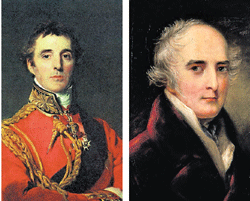He kept the British guessing
Feudal lord Dhondia Wagh’s rebellion against the British gave them many sleepless nights. He eventually met his end at the hands of Arthur Wellesley, later Duke of Wellington, at Raichur in 1800. Our chroniclers have not given Dhondia much credit though, observes D C Bakshi

In the popular mind, the fame of Tipu Sultan rests without question, almost solely, due to his strong opposition to the British. An intrepid fighter, a king-soldier; he died fighting against the British in the Battle of Srirangapatna. The echoes of Tipu’s death were heard right up to London, where the civic authorities lost no time in naming a road after the vanquished state, namely a Mysore Road, in the heart of the British capital!
Tipu was a sort of ‘Eastern Boney’; such was the fear of this Indian ruler amongst the English populace that the harried mothers of young toddlers scared their naughty children with his name. In that complex and fierce struggle of survival at Srigangapatnam, along with Tipu Sultan, a large number of leading army commanders of the Mysore army too perished.
The imperial state prison had many captives whose disposal was yet to be decided. In the melee that followed after the collapse, a few of them were released by the new management; yet a large number of them escaped.
As per historical records, Purnaiah, (called Purnea) was retained Dewan of the State and Arthur Wellesley (the future Duke of Wellington) was appointed as Military Commander – to restore law and order.
Historians confirm, that by and large, the “take-over” of Mysore State was peaceful except for the fact that a few dissidents, rebellious and unrepentant craved for independence; they looked for a resolute leader who would be capable of locking horns with the British.
Prominent amongst the revival-brigade, aspiring for freedom was Dhondia Wagh, an erstwhile feudal lord, who had earlier enjoyed Tipu’s confidence, but landed in jail due to serious differences with the ruler – he was awaiting execution. The proverbial lull gave him an opportunity to escape.
Once out of jail, Dhondia enlisted a large number of followers and assumed the title of ‘Ubhaya Lokadheeshwara’ (‘master of two worlds’). Being a son of the soil, he could easily muster support from major and minor principalities. The provinces of the then Dharwar and Hassan announced their allegiance to him and provided support in terms of men and material.
Himself an adept cavalry commander, the strength of his troops rose to 50,000 within a short span of time. Most of his soldiers were mounted and they could move twice as far in a day as a regular force. For logistics, he employed teams of banjara volunteers. Having consolidated his position, he sent stiff warnings to the new British regime. “I demand that you liberate and deliver to me Tipu’s sons or else I will lay waste the country from Srirangapatnam to Mysore,” he warned them.
Taking on the British
As expected, this tongue-lash was unacceptable to British higher authorities and they looked for an opportunity to eliminate him. When news of the ‘menace’ reached Sir Marquess Wellesley, the Governor General (Arthur Wellesley’s elder brother), he ordered Arthur “to hang him (Dhondia Wagh) to the first tree”. Thus the British set their sights on capturing Dhondia dead or alive. Seeking assistance from the Marathas, the Duke left Srirangapatna in early June 1800 to wrest the initiative for offensive operations against Dhondia before the onset of the monsoon.
It was this same Duke, who, 15 years later, defeated the famous French Emperor General Napoleon Bonaparte at the battlefield of Waterloo (Napoleon at that time ruled half the Europe directly and the other half indirectly. Bonaparte’s presence alone at the battlefield was equivalent to 50,000 combatants, according to experts who have researched on Napoleonic wars). He was currently hard-pressed by an “irregular southern freebooter”.
Dhondia Wagh kept the English commander guessing for three months. He finally came face to face with Arthur Wellesley on September 10, 1800 at Conaghalli, also called Konagal, in Raichur district. British Commander Arthur Wellesley, formed his entire army into a “single-line formation” (with no reserves) and led the charge himself. Dhondia was killed in action. He was then 60 years of age.
“I understand as much of military matters when I came back from India, as I have ever done so,” the Duke said long after Waterloo, eulogising the expertise gained in India. Well, he was not wrong, his baptisation in land-warfare took place in India. From February 1797 to September 1805, during his stint in India, the Duke had scored decisive victories at Ahmednagar, Assaye, Argum and Gwalighur. The historic clash with Dhondia Wagh at Conaghalli was in fact, his first major field experience.
It is interesting to note that this confrontation has a laudatory mention – as a stroke of “grand success” – amongst the numerous battles fought by the Duke and duly recorded in most of his biographies and military encyclopedias – but regrettably our Indian chroniclers have not given the well-deserved credit to Dhondia Wagh for the stiff resistance put up by him against a foreign ruler.
The battlefield at Raichur may not be in the same league as the resistance put up against the British at Haldighati or Kanua since it was not motivated by the collective surge of masses of the region against the aggressor. But Dhondia Wagh’s uprising definitely gave many sleepless nights to the British rulers of those times.
Deccan Herald is on WhatsApp Channels| Join now for Breaking News & Editor's Picks